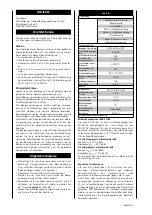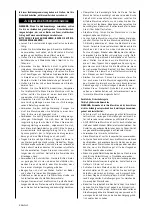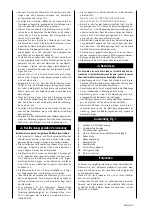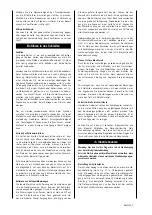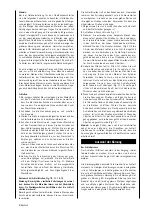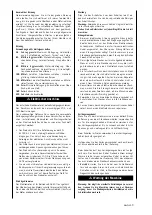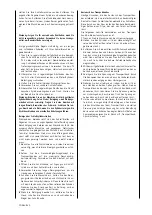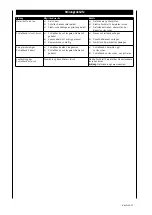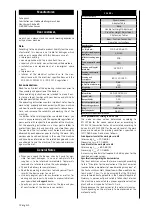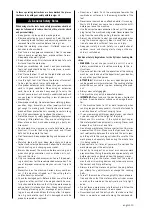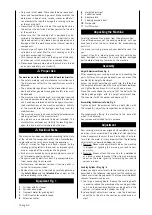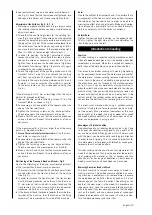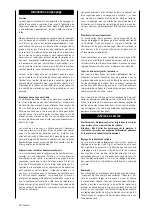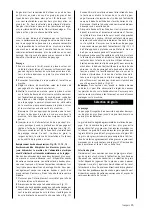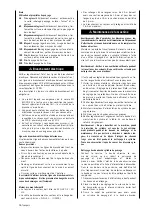
english 13
In these operating instructions we have marked the places
that have to do with your safety with this sign:
m
m
General Safety Rules
When using electric tools basic safety precautions should al-
ways be followowed to reduce the risk of fire, electric shock
and personal injury.
• Keep guards in place and in working order.
• Remove adjusting keys and wrenches. Form the habit
of checking to see that keys and adjusting wrenches are
removed from the machine before turning it on.
• Keep the working area clean. Cluttered areas and
benches invite accidents.
• Don’t use in a dangerous environment. Don’t use power
tools in damp or wet locations, or expose them to rain.
Keep work area well lighted.
• Keep children away. All visitors should be kept at a safe
distance from the work area.
• Make your workshop kid proof. Lock your workshop.
Tools not used should be kept in a dry place, inacces-
sible for children.
• Don’t force the tool. It will do the job better and safer
at the rate for which it was designed.
• Use the right tool. Don’t force the tool or attachment
to do a job for which is was not designed.
• Use proper extension cord. Make sure your extension
cord is in good condition. When using an extension
cord, be sure to use one heavy enough to carry the
current your product will draw. An undersized cord will
cause a drop in voltage resulting in loss of power and
overheating.
• Wear proper clothing. Do not wear loose clothing, gloves,
neckties, rings, bracelets, or other jewelry which may
get caught in moving parts. Nonslip shoes are recom-
mended. Wear protective hair covering to contain long
hair. Roll your sleeves up to above the elbows.
• Protect your eyes by safety goggles. Everyday eyeglasses
offer only little protection. They are no safety glasses.
Wear a face or dust mask when working in a dusty en-
vironment.
• Secure work. Use clamps or a vice to hold work, when
practical. It is safer than using your hand, and it frees
both hands to operate the tool.
• Don’t overreach. Keep proper footing and balance at all
times.
• Maintain tools with care. Keep tools sharp and clean
for best and safest performance. Follow the instructions
for lubricating, and changing accessories.
• Always disconnect the machine before servicing, and
when changing accessories, such as blades, bits, cut-
ters, and the like.
• Only use recommended accessories. Consult the operat-
ing instructions for the recommended accessories. The
use of improper accessories may cause risk of injury to
persons.
• Never stand on the machine. Serious injury could oc-
cur if the machine is tipped or if the cutting tool is
unintentionally contacted.
• Check for damaged parts. Before further use of the tool,
a guard or other part that is damaged should be care-
fully checked to determine that it will operate properly
and perform its intended function. Check for alignment
or binding of moving parts, breakage of parts, mount-
ing, and any other conditions that may affect its opera-
tion. A guard or other part that is damaged should be
properly repaired or replaced.
• Direction of work. Push the workpiece towards the
sawblade or cutter only in the moving direction of the
tool.
• Never leave the machine unattended while it is running.
Wait until the tool has come to an absolute standstill,
before you leave the machine.
• Use the correct power connection. Do not pull the power
plug to stop the machine during work. Never remove the
plug from the socket by pulling the extension cord.
• Always stay attentive to what you are doing, even when
using the machine regularly. Bear in mind that a frac-
tion of a second is sufficient to cause an injury.
• Keep your safety in mind. Safety is a combination of
common sense and staying alert as long as the ma-
chine is switched on.
Additional Safety Regulations for the Cylinder Sanding Ma-
chine
•
WARNING: Do not use your machine until it is com-
pletely assembled and installed according to the in-
structions.
• If you are not familiar with the operation of the sanding
machine, ask the head of the department, your teacher,
or any other qualified person.
•
ATTENTION: This machine has only been designed for
sanding wood or similar materials. The sanding of other
materials can cause fire, injuries, or damage the prod-
uct.
• Always wear safety goggles.
• This machine may only be operated indoors.
•
IMPORTANT: Mount and use the machine on a horizontal
surface. A non-horizontal surface can damage the mo-
tor.
• If the machine tends to tilt or walk (especially when
sanding long and heavy panels), it must be fastened to
a solid surface of sufficient carrying force.
• If you are working with larger work pieces, you should
use extra support at the height of the table.
• Never use this machine, if the cylinder dust cap or
the motor protective equipment is missing. Never sand
deeper than 0.8 mm at one time.
• Do not sand work pieces that are shorter than 76 mm or
narrower than 19 mm. Make sure that you have the cor-
rect relationship between the entry and the exit areas,
and the path to the sanding cylinder. Be sure that the
work piece is adequately fixed during the whole time
it is being sanded.
• Keep control at all times of your work. Do not lean the
work piece against the entry table.
• Do not try to carry out an unusual or uncommon work
process without fixing the work piece appropriately, and
before you really understand how the process works.
• Before turning on the motor, check that the adjust-
ments and all clamping devices and screws are assure
the correct and firm positioning.
• Always turn off the motor and pull out the plug, before
you attempt any adjustments or change the sanding
belts.
• Turn off the machine after roughly fifty hours of opera-
tion and check that the motor and the cylinder screws
as well as the screws on the entry rolls are fully tight-
ened.
• Do not force a work piece into the machine. Allow the
sanding machine to work at its own speed.
• Occasionally check the entry belts, to make sure that
there is no waste or sawdust among the components.



